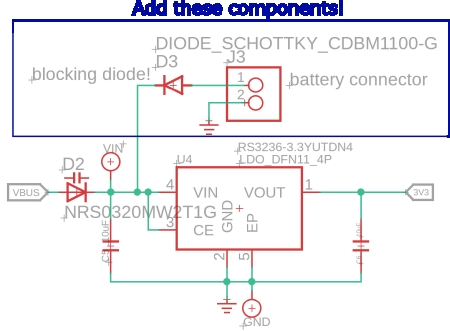| Xiao version |
Compatible batteries |
Caveats |
Charging included? |
Schematic |
| RP2040 |
1S LiPo or 3 Alkaline cells for 4.5V |
Requires blocking diode to prevent charging battery!
Will lose the bottom portion of 1S cells due to regulator drop |
No |
Link |
| SAMD21 |
1S LiPo or 3 Alkaline cells for 4.5V |
Requires blocking diode to prevent charging battery!
Will lose the bottom portion of 1S cells due to regulator drop |
No |
Link |
| ESP32 C3 |
1S LiPo, 3 Alkaline cells for 4.5V, or 1S LiFePo |
Requires blocking diode to prevent charging alkaline cells or LiFePo
Better regulator with lower losses |
Yes 1S LiPo |
Link |
| ESP32 S3 |
1S LiPo, 3 Alkaline cells for 4.5V, or 1S LiFePo |
Requires blocking diode to prevent charging alkaline cells or LiFePo. Lowest losses |
Yes 1S LiPo |
Link |
| ESP32 C6 |
1S LiPo, 3 Alkaline cells for 4.5V, or 1S LiFePo |
Requires blocking diode to prevent charging alkaline cells or LiFePo. Lowest losses |
Yes 1S LiPo |
Link |
The blocking diode is required on the Samd21 and RP2040 boards to ensure that current can flow out of the battery but not into it. Without this diode having the USB C cable plugged in to charge/program while the battery is plugged in will at best destroy your battery and at worst light it on fire! The diode and connector must be added externally on your PCB before connecting to the bottom Vin pin of the Xiao.
The latter Xiao boards implement a full Battery Management System (BMS) which makes it safer and handles charging so that you can happily plug in the USB C cable as a way to charge a 1S lipo pack.
All of the Xiao boards require a blocking diode if you are to use any non-rechargeable batteries or chemistries other than LiPo. Failure to include this will again result in battery death or fire.

